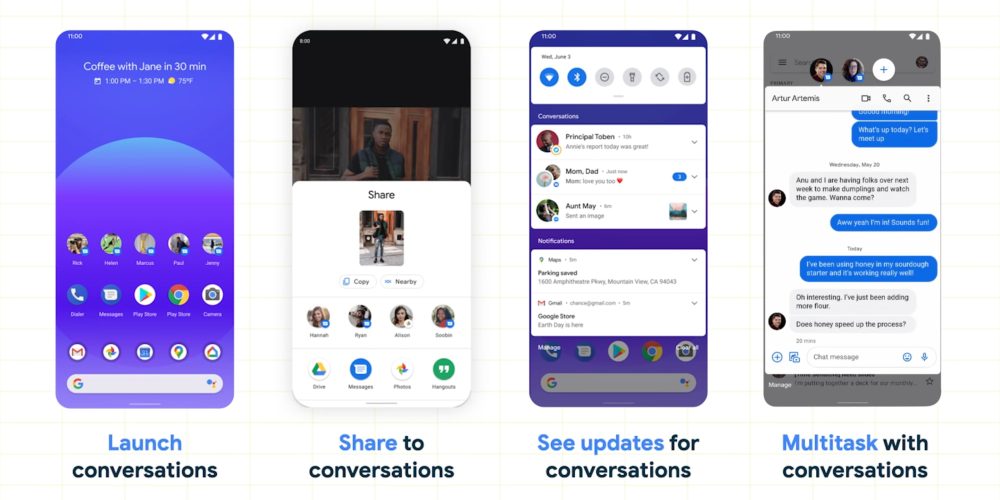
It’s rather hard to change how people use their phones. One recent example was Google wanting to meaningfully change how you interacted with “People and conversations” on Android in large parts through widgets.
Google made “People and conversations” a tentpole of Android 11 back in 2020. It — correctly — identified that “communicating with your friends and colleagues is the most important thing many people do on their phones.”
For end users, this initiative manifested as a dedicated “Conversation” section at the top of the notification shade, with a tap opening that messaging thread in a floating chat head bubble. You were also given the ability to give specific conversations “Priority” and custom sounds or vibrations.
Android 11:

Android 12 continued that focus with the introduction of a “Conversation Widget.” The homescreen object was meant to “promote user interaction by allowing them to easily open chats on the home screen.”
These widgets are enhanced shortcuts that allow users to efficiently get back to their conversations while showing snippets of their conversation status or other relevant information.
Google imagined this widget displaying everything from upcoming birthdays to what songs friends are listening to and what movies/games they are playing. Another example was location sharing, missed calls, and if they were exercising. The full list of supported “activities” includes:
- Anniversary: “representing that the conversation user and the device user are celebrating an anniversary today.”
- Audio: “representing that the conversation user is listening to music or other audio like a podcast.”
- Birthday: “representing that today is the conversation user’s birthday.”
- Game: “representing that the conversation user is playing a game.”
- Location: “representing that the conversation user is sharing status with the device user.”
- New story: “representing that the conversation user has posted a new story.”
- Video: “representing that the conversation user is watching video content.”
- Status: Whether a person was available, busy, or offline
Google’s Android 12 mockup
In practice, the Conversation Widget today mostly just shows the last sent chat (in Google Messages). Other developers did not really use the space for anything, while Google — with the Android 12 Material You redesign — dropped the idea of [Update: an explicitly labeled, but otherwise still present] “Conversation” space in the notification shade.
Broad adoption of Google’s vision would have contributed to a meaningfully different way of using your phone. Instead of opening an app, imagine being able to see information directly on your homescreen. (Think Windows Phone Live Tiles but much richer.) That would result in a highly glanceable experience that’s an efficient way to quickly get updates about your most important people. In fact, you might not need to open an app in the first place if all you intended to do was get a status update.
Additionally, updates on your homescreen would have offered a meaningful alternative to notifications that are less invasive and do not inundate you as you’re in control over who gets a widget. Both Android and iOS have the concept of badges appearing on app icons, but they are just in service of getting you to open an app to get anything done. Design-wise, the Conversation Widget — as any widget — showed you a lot more live info without then having to open an app.
Apps as silos is something I’ve written about previously in the context of Google Now. The metaphor of apps is very simple. You open one to complete an action. However, the express purpose of an app/service is to get you to spend as much time as possible within it. In that sense, it’s isolating from the rest of your phone.
That ingrained model is one reason the Conversation Widget never took off. There isn’t real developer incentive to show information (besides notifications) outside of the app. Another is that Google never really encouraged the apps it controls — Maps for location sharing and activity statuses from YouTube, YouTube Music, Stadia, and Play Games — to adopt the vision to serve as high-profile demos. It would have of course helped if Google had a modern consumer messaging service that wasn’t based on SMS (or even RCS) to implement these social features.
At the time of Android 11’s developer introduction, Google said the “people and conversations initiative is a multi-year Android initiative that aims to elevate people and conversations in the system surfaces of the phone.” Android 12 saw an advance (widget), while Android 13 saw no new movement.
Hopefully, Google has not concluded the People and conversations initiative. It went under the radar at the time, but it could be revolutionary if there was even some adoption by first-party Google services. Apps would go from walled off experiences to services that natively integrate with Android. It would offer a meaningfully different way to use a smartphone, and that should not be abandoned without another push.
Add 9to5Google to your Google News feed.
google-news
Author: Abner Li
Source: 9TO5Google








